
Next we’re going to take a brief look at some of the patterns and shapes that the planets make in a birth chart. This will give you even more information about how the planets are playing out in your chart. When three or more planets are connected to each other by aspect, they form a pattern. Understanding these patterns will build on the information you’ve already absorbed regarding the five basic aspects; for example, you know now that a square is challenging, but a T-square aspect pattern is even more challenging!
The Grand Trine, T-Square, Yod and Kite are some of the major aspect patterns, so let’s explore these.
This is when you have two planets in opposition with a planet ‘in the middle’ of the two opposing planets, squaring both. See the illustration on the following page. One square is challenging but in the T-square there are not one but two squares and an opposition. There is push and shove with the T-square.
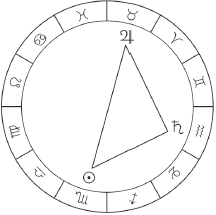
Figure 11: The T-square
If you have a T-square in your chart, take a look at all the factors involved – the planets, signs and houses. These will help you to build up a picture of the issues likely to come up for you.
Here, three planets are connected by three trines to form a triangle, the Grand Trine.
Figure 12: The Grand Trine
The Grand Trine shows flowing energies that go from one to the next. This aspect pattern reminds me of people holding hands and sending love around a circle. Any planetary influences in a Grand Trine circulate easily: in fact, sometimes too easily.
There are four different types of Grand Trine – one for each element.
Can you see a Grand Trine in your chart? Grand Trines can be where you are a little on the lazy side! Overall though, I would consider a Grand Trine a blessing.
This is a rare aspect between three planets, or other points, that form a triangle. Two planets are sextile and the third is quincunx (150 degrees apart), on their midpoint.
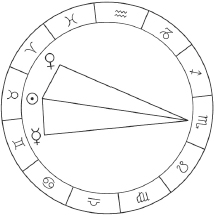
Figure 13: The Yod
Many say that the Yod suggests a special mission or destiny in life, and for this reason it’s also called the Finger of God. However, others argue it’s not all that informative. I would argue that we all come to Earth with a special mission or destiny, and that we don’t need a Yod in our charts for that.
Can you see a Yod in your chart? At its best, a Yod may challenge you to move from what is easy (sextile) to something far more awkward (quincunx) to live out your special mission.
The wonderful-sounding Mystic Rectangle occurs when four or more planets are connected by sextiles, trines and oppositions.
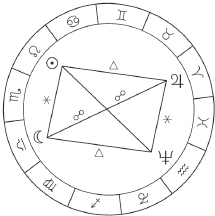
Figure 14: The Mystic Rectangle
The Mystic Rectangle allows the individual to work well in life, in whatever field they choose, personally and professionally. There is an energy flow.
Is there a Mystic Rectangle in your chart? This pattern is said to confer psychic ability, and it offers a strong sense of balance and harmony between the four planets involved.
A Kite is a Grand Trine with a fourth planet opposing one of the three planets in the Grand Trine and sextiling the other two.
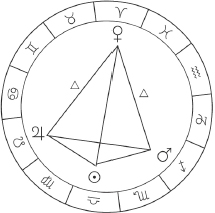
Figure 15: The Kite
The Opposition here is like the grit in the oyster that creates the pearl. On its own, a Grand Trine can be pleasant but it may not lead to grand and concrete developments. The Opposition gives the individual a sense of direction and focus and acts like an anchor for all that’s good about the Grand Trine.
Can you see a Kite in your chart? This pattern adds tension to your chart, and helps you to make the most of the positive energies it contains.
Once you’ve taken a good look at your chart, you may notice that you have a lot of planets in one place or large empty sections. What follows is a brief look at how to interpret the various patterns you might see.
When the planets are laid out in the chart in two opposing groups, it suggests that there are lots of ‘opposites’ in the individual, perhaps playing out as contradictions. With this pattern, there’s often a sort of see-sawing between one way of being and another.
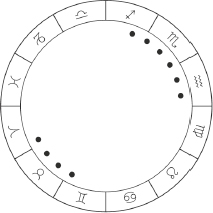
Figure 16: The see-saw
Here, the planets are in tight groups of three or four. This has the effect of highlighting several houses, which may become the most important houses (or areas of interest) in the individual’s life.
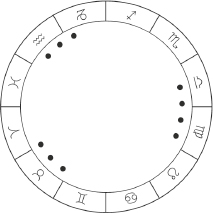
Figure 17: The tripod/splay
In this pattern, all the planets are bunched together and take up two-thirds of the chart, leaving one third, or 120 degrees, empty. This suggests a certain emphasis on one part of the chart, whereas the other part of the chart, where there are no planets, is less of a focus.
Figure 18: The locomotive
This is when all the planets in the chart are on one side, except for the ‘singleton’ on the other side. The singleton becomes a very important planet in the chart of the person with this layout, both in terms of how it’s expressed in the birth chart and what happens when it’s transited by other planets.
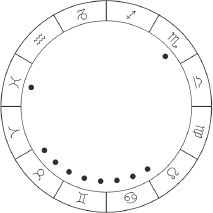
Figure 19: The bucket
Here, the planets are gathered together within 120 degrees of each other. This confers areas of special interest. If you have a lot of planets in one particular part of your chart, your focus in this lifetime will be on those areas, taking into account the sign and house the bundle or wedge is in.
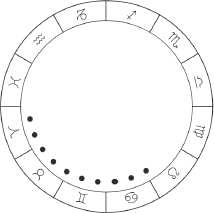
Figure 20: The bundle or wedge
This is when the planets are evenly spread out around the zodiac/chart. The individual has a wide range of gifts and abilities; however, they also need to focus on one thing at a time to achieve their goals.
Figure 21: The splash
You should now have an understanding of the main chart patterns to look for when viewing your own or someone else’s chart.
Once you start to look at charts more regularly, you may find that the patterns start to jump out at you rather quickly. They are a sort of visual shorthand and carry a lot of clues about the chart’s overall character.
Next we will look at something even many non-astrologers have heard of – retrograde planets. If you have ever wondered about Mercury retrograde or the meaning of any other planet’s retrograde, read on!